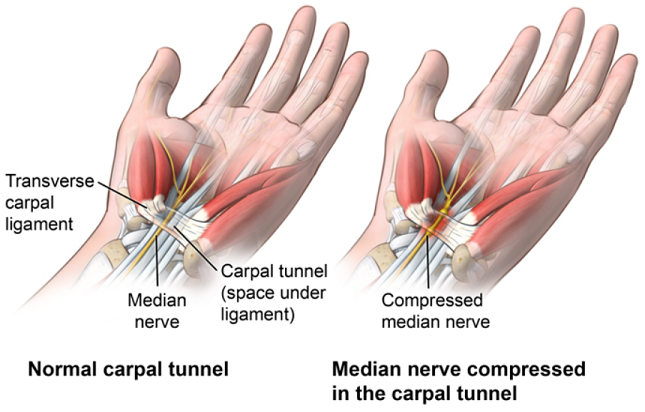Inova Peripheral Nerve Center
The Inova Peripheral Nerve Center provides cutting edge surgical treatment for pain caused by injury to nerves, compression of nerves, and conditions of the peripheral nervous system such as carpal tunnel syndrome, thoracic outlet syndrome, and amputation stump pain.
What is peripheral nerve pain?
 The peripheral nervous system is comprised of the nerves outside of our brain and spinal cord: the nerves in your face, arms and legs, and in your chest and abdomen. The peripheral nervous system sends messages from our brain that communicate with the rest of our body. Whether caused by traumatic injury, surgery, or conditions such as carpal tunnel syndrome, damage to the peripheral nerves can lead to chronic pain that is often difficult to diagnose.
The peripheral nervous system is comprised of the nerves outside of our brain and spinal cord: the nerves in your face, arms and legs, and in your chest and abdomen. The peripheral nervous system sends messages from our brain that communicate with the rest of our body. Whether caused by traumatic injury, surgery, or conditions such as carpal tunnel syndrome, damage to the peripheral nerves can lead to chronic pain that is often difficult to diagnose.
Who is a possible candidate for nerve surgery?
The Inova Peripheral Nerve Center is one of only a handful of institutions in the country that are currently offering these surgeries for patients who have exhausted other treatment options. Patients come to us with pain caused by conditions including:
- Hand numbness or weakness
- Persistent arm/hand/leg/foot pain after traumatic injuries or surgery
- Chronic headaches that are not relieved by prescription medications
- Groin pain after hernia repair
- Unrelenting pain after laparoscopic surgery, breast reconstruction, Caesarian section, abdominoplasty, etc.
- Phantom Limb or Amputation Stump Pain (neuromas)
- Thoracic Outlet Syndrome
- Compression neuropathy / pinched nerve
- Nerve injury
Carpal Tunnel Syndrome
Carpal tunnel syndrome is when the median nerve is compressed as it passes through the carpal tunnel. The carpal tunnel is an opening in your wrist that is formed by the carpal bones on the bottom of the wrist and the transverse carpal ligament across the top of the wrist. The median nerve provides sensory and motor functions to the thumb and 3 middle fingers. If it gets compressed or irritated, you may have symptoms. Read more about carpal tunnel syndrome in the Inova Health Library 
Thoracic Outlet Syndrome
Thoracic outlet syndrome refers to a variety of symptoms that happen from a narrowing of your thoracic outlet — the space between your collarbone and your first rib. It can result from injury, disease, or a problem present from birth.
The thoracic outlet is a narrow space between your collarbone (clavicle) and your first rib. Nerves and blood vessels exit from your chest to your arm through this passageway. This includes a very large important artery (the subclavian artery), a large and important vein (the subclavian vein), and a bundle of nerves that serve your shoulder, arm, and hand. Your shoulder muscles normally keep your clavicle elevated and in place.
Various conditions can cause your collarbone to slip down and forward. This narrows the thoracic outlet and puts pressure on the nerves and blood vessels here. This causes the symptoms of thoracic outlet syndrome.
Healthcare professionals sometimes categorize thoracic outlet syndrome according to its underlying cause. For example, “cervical rib syndrome” refers to a type of thoracic outlet syndrome that can happen if a person has an extra upper rib. Clinicians also sometimes categorize thoracic outlet syndrome according to the structures compressed. Nerve, vein, and artery compression may all cause different symptoms (though there might be compression on more than one structure). Thoracic outlet syndrome is relatively uncommon. Women get it more often than men do. It can happen in people of any age. Read more about thoracic outlet syndrome in the Inova Health Library
Planning for your peripheral nerve center consultation
Identifying the cause of your pain is not always straightforward. Many patients will have seen several other physicians, physical therapists, or pain specialists without complete relief of their pain. In order to schedule your initial consultation, we ask that you obtain a referral from your current primary care doctor or specialist. We will work with you to obtain the necessary information ahead of time regarding all consultations and interventions. During your consultation, you will be asked to provide: a complete medical history, including information about previous surgical procedures, past and present medical conditions, any medications or supplements you are taking. Please understand that communication is crucial, during your consultation you and the surgeon will discuss your goals and reach an understanding about what you can expect from the proposed procedure.
Location
Our office is located on the first floor of Inova Mount Vernon Hospital, near the yellow lobby entrance. To schedule a consultation, call 703-972-6655.
Top of page